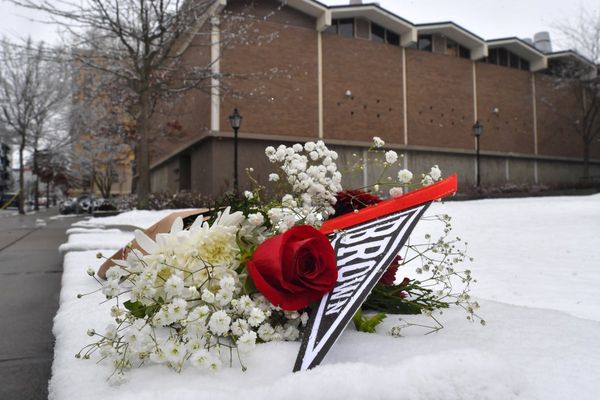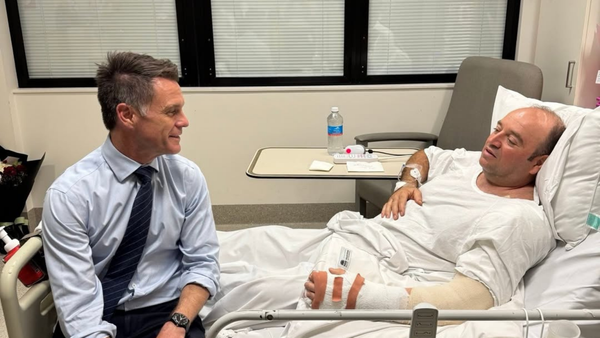On the sideboard of his Burnley home Andy Payton displays the spoils of war. Presented in honour of the 27 goals he scored for his hometown team in their promotion season of 1999-2000 an Adidas golden boot takes pride of place. There’s an award to mark the 200th strike of his playing career. Propped up against the wall, in a black frame behind, is the back page of a Sunday newspaper from March 1993.
‘Bloody Magic’ is the headline on an image of his wounded head, vaseline plastered over a gash inflicted by the flailing right arm of Rangers left-back David Robertson. “I was elbowed in the head,” the former Celtic striker recalls now. “But back in the day you went off and got it stitched up and got straight back on.”
Minutes earlier Payton had thumped a John Collins corner into the net in a rare win over Rangers for Liam Brady’s Celtic team. A frantic, blood-and-thunder battle symptomatic of Old Firm games of the past Payton had signed from Middlesbrough for £600,000 a year earlier. A direct, physical, up and at ’em British centre forward, the cut and thrust of Scottish football seemed to suit him.
“Mark Hateley is in the background and what that picture reminds me of is the intensity of the Celtic and Rangers games back then,” he says.
“It was so much more physical than it is now. Rangers back then had Hateley, [Richard] Gough, Trevor Steven, Ally McCoist and John Brown and the players were literally kicking lumps out of each other. But any striker who goes to Celtic – whether it’s today or 30 years ago – knows that if they can score the winner against Rangers then that’s what it’s all about. That’s why, at that time, scoring the winner against Rangers felt like it was worth all the blood and the stitches.”
Recent events have given him cause to reconsider that judgement. Over the course of a 16-year career Payton scored 226 goals in 588 appearances for seven clubs. His first stop was Hull City, where he practiced heading drills, day in and day out, with former Aberdeen striker Dean Windass.
Earlier this year Windass was diagnosed with stage two dementia after he was persuaded to undergo a brain scan by his friend John Stiles – son of Nobby, the England World Cup winner who died after a long fight with the same illness.
Payton had kept in touch with his former team-mate on and off. When he confided in him over his own episodes of memory loss and the blinding headaches which forced him to seek refuge in a darkened room for hours on end, Windass urged him to have it checked out.
“It just didn’t feel right. Deano still lives in Hull and it’s a little bit like when you have mates at school and you keep in touch now and again. We’d exchanged messages on and off and he recognised the signs.
“I’m not one of those soft people who say, ‘I’ve got a bit of a headache…’ Some people have the slightest thing happen and they’re unwell, I’m not like that at all. We’re talking bad, a lot of pain and I had never had any health issues. That’s what led me to go for the brain scans and when they came back they revealed that out of the 60-plus tracts in the brain 27 showed damage. I can’t say I was surprised that I was diagnosed with early onset dementia because there had been little bits of memory loss. My missus had started to notice little signs.”
At Hull City heading drills were a daily ritual. Payton remembers sessions where he and Windass would head the ball 150 to 200 times in two hours. Crosses were fired in by wingers from the left and the right and holding back was discouraged.
The effects of heading footballs at high speed became clear when the FIELD study, led by the University of Glasgow in conjunction with the Football Association and Professional Footballer’s Association, studied data from 7676 former professional footballers and found that they were 3.5 times more likely to die from neurodegenerative disease. Former players were five times more likely to develop Alzheimer’s disease, four times more likely to develop Motor Neurone Disease and twice as likely to develop Parkinson’s.
The football associations of England, Scotland and Northern Ireland responded by banning children from heading balls in training, depending on their age. In 2022 the Scottish FA introduced new guidance banning professional players from heading the ball during training on both the day before and the day after a match.
When the likes of Stiles, Jack Charlton, Jeff Astle, Joe Kinnear, Jimmy Calderwood, Gordon McQueen, Billy McNeill and former Scotland manager Ally MacLeod played the game, safeguards were unheard of. Heading the ball freely, without inhibition, was a part of the working day.
“It’s beyond doubt, for me, that heading the ball as often as I did caused this,” says Payton now.
Read more
- Why ex-Celtic manger Postecoglou has to bin Angeball to avoid Nottingham Forest sack
- What it was like inside Brendan Rodgers' explosive Celtic press conference
“It was so physical back in my day, even in training. You came up against the old-fashioned centre-halves and they would not only smash you, they would tell you they were going to do it just before they did.
“That day against Rangers I went off to get five stitches in my head. I went straight into the treatment room, got stitched up then went straight back on. Could you imagine that in football now?”
For the last 10 years Payton has worked as a part-time football coach at Burnley College, but frets over a future less certain than it used to be.
He supports Football Families for Justice, a voluntary organisation run by John Stiles, to support former footballers and their families. Fighting to raise awareness – and funds – for relatives left to address the crippling care home costs of ex-players FFJ believe the Football Brain Health Fund established by the English Premier League and PFA is shamefully inadequate.
Currently 33 former footballers are pursuing a joint legal action against the Football Association in the High Court for failing to protect them against chronic traumatic encephalopathy, dementia and other neurological conditions. Speaking at the end of the debate on the Football Governance Bill, Lisa Nandy, Secretary of State for Culture, Media and Sport promised to ‘get to grips’ with the issue after 303 former players – including Kevin Keegan and Graeme Souness – signed a letter calling on the government to force football to take the welfare of ex-players seriously.
“Care home costs are astronomical and it shouldn’t be the taxpayer meeting the cost of the care. It’s clear to me that there is not a proper fund that takes care of players and their families and there should be.
“I look at deadline day the other week when clubs spend £2.5 billion. And yet the PFA are putting just £1 million a year into a Brain Health Fund when they’re paying their chief executive (Maheta Molango) £650,000 a year. Start adding up care home costs and £1 million pays for what? Four players?”
While football clubs in England – and, to a lesser extent, Scotland – continue to throw millions of pounds at transfer deals and agents’ fees, sympathy for the players of yesteryear is diluted by a common misconception. While many lived in a nice semi in a suburb, owned a car and earned more than miners or steel workers or bus drivers the income of the average pro could still be measured in hundreds rather than thousands of pounds. Few, if any, earned the fortunes required to support the crippling cost of social care.
“Footballers of today can get a contract at 17 or 18 and be on £40k a week over five years before they’ve scored a goal for the first team,” Payton observes.
“At Hull City I was in the Championship at 19 and when I scored on my debut against Leeds United I was on £70 a week. And I brought £58 home after tax.
“I was at Celtic with people like Paul McStay, John Collins and Frank McAvennie and Charlie Nicholas.

“Players of that calibre in the modern era would be multi-millionaires. I wouldn’t have been far behind myself, just going off the amount of goals I scored and where I scored them. But players in our era were nowhere near that. “And now that generation of players, including me, are having these problems and to me it’s beyond all reasonable doubt that heading a ball 200 times a day in training has caused this. The taxpayer shouldn’t be footing the bill for that.”
Scoring goals everywhere he played, regrets over his career are few. He wishes he’d headed the ball a good deal less and, in hindsight, feels he could have stayed at Celtic and fought for his place.
Liam Brady’s resignation in October 1993 paved the way for Lou Macari’s arrival, the dysfunctional decision making of the time was summed up by the new manager agreeing a deal with Barnsley to swap Payton for Wayne Biggins, a 33-year-old journeyman striker who made six appearances and failed to score a goal.
“Wayne came up and didn’t get any goals and I’d never want to call out a player, but that was Macari’s decision and I still managed to finish up top scorer that season.
“When you look at memories like playing for Celtic and scoring the winner in an Old Firm game and winning a golden boot for Burnley, my hometown club, those are magic moments.
“But they have come at a high price. Because a lot of players like myself are worried about what happens to us now.
“We didn’t know what heading a ball would do to us. And I would have taken a lot more precautions if I’d known I’d be in this situation now.
“Football could sort this out from loose change. I’m only 57 and I think there are 300 players in the same position. I hope, with me, it’s a slow burner. But when you have been for the scans and you’re being told half your brain is abnormal you don’t really know, do you?”







